
Operation Bodenplatte, launched on 1 January 1945, was an attempt by the Luftwaffe to cripple Allied air forces in the Low Countries during the Second World War. The goal of Bodenplatte was to gain air superiority during the stagnant stage of the Battle of the Bulge so that the German Army and Waffen-SS forces could resume their advance. The operation was planned for 16 December 1944, but was delayed repeatedly due to bad weather until New Year's Day, the first day that happened to be suitable.
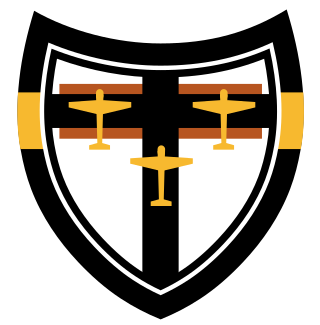
Jagdgeschwader 27 (JG 27) "Afrika" was a fighter wing of the Luftwaffe during World War II. The wing was given the name "Africa" for serving in the North African Campaign predominantly alone in the period from April 1941 to September 1942. Elements of JG 27 fought in every major theatre of operations in which the Wehrmacht operated.

Jagdgeschwader 77 Herz As was a Luftwaffe fighter wing during World War II. It served in all the German theaters of war, from Western Europe to the Eastern Front, and from the high north in Norway to the Mediterranean.
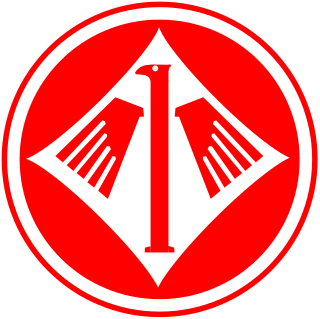
Jagdgeschwader 1 (JG 1) "Oesau" was a German World War II fighter wing created in 1939. Between 1940 and 1942, JG 1 operated primarily over the Western Front and northern occupied Europe. During the initial days of the war, JG 1 faced little resistance, apart from occasional Royal Air Force (RAF) excursions. The unit was rarely engaged in large-scale confrontations during this time.
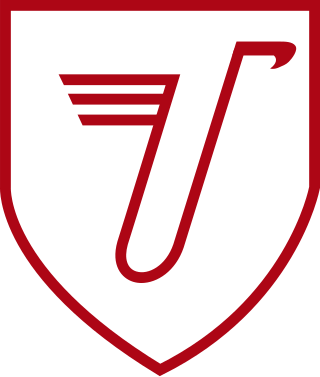
Jagdgeschwader 3 "Udet" was a Luftwaffe fighter wing of World War II. The Geschwader operated on all the German fronts in the European Theatre of World War II. It was named after Ernst Udet, an important figure in the development of the Luftwaffe, in 1942.
Jagdgeschwader 7 Nowotny was a Luftwaffe fighter wing during World War II and the first operational jet fighter unit in the world. It was created late in 1944 and served until the end of the war in May 1945.

Kurt Bühligen was a Luftwaffe wing commander and fighter ace of Nazi Germany during World War II. He was credited with 112 enemy aircraft shot down in over 700 combat missions. His victories were all claimed over the Western Front and included 24 four-engine bombers and 47 Supermarine Spitfire fighters.

Georg-Peter "Schorsch" Eder was a German Luftwaffe military aviator and fighter ace during World War II. He is credited with 78 aerial victories achieved in 572 combat missions, including 150 combat missions with the Messerschmitt Me 262 jet fighter. This figure includes 10 aerial victories on the Eastern Front, and further 68 victories over the Western Allies, including 36 four-engined bombers.

Herbert Ihlefeld was a German Luftwaffe military aviator during the Spanish Civil War and World War II, a fighter ace listed with 130 enemy aircraft shot down in over 1,000 combat missions. Depending on source, he claimed seven to nine aerial victories in the Spanish Civil War, and during World War II, 67 on the Eastern Front and 56 on the Western Front, including 15 four-engined bombers and 26 Supermarine Spitfires. He survived being shot down eight times during his 1,000 combat missions.
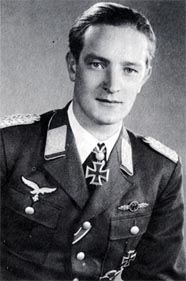
Friedrich-Karl "Tutti" Müller was a German Luftwaffe military aviator and wing commander during World War II. As a fighter ace, he is credited with 140 aerial victories claimed in more than 600 combat missions. He claimed eight aerial victories during the Battle of France, 89 on the Eastern Front, and further 43 victories against the Western Allies in the Mediterranean Theatre and in Defense of the Reich, including 24 four-engined bombers. He was "ace-in-a-day" four times, shooting down five or more aircraft on a single day.

Ernst-Wilhelm Reinert was a German Luftwaffe military aviator during World War II, a fighter ace credited with 174 enemy aircraft shot down in 715 combat missions. The majority of his victories were claimed over the Eastern Front, with 51 in the Mediterranean theatre and 20 over the Western Front. He was "ace-in-a-day" four times, shooting down five or more aircraft on a single day.

Siegfried Freytag was a World War II German Luftwaffe pilot and wing commander. As a fighter ace, he was credited with 102 aerial victories of which 49 victories were claimed over the Eastern Front. Among his victories over the Western Front are at least 2 four-engine bombers. He was a recipient of the Knight's Cross of the Iron Cross Freytag had been nominated for the Knight's Cross of the Iron Cross with Oak Leaves, but the war ended before the paperwork had been processed.

Gustav Rödel was a German fighter pilot and fighter ace who served during World War II in the Luftwaffe.
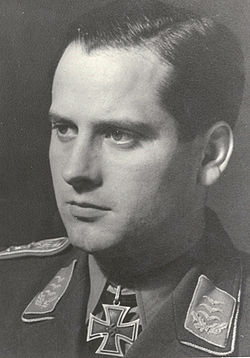
Gerhard Schöpfel was a German Luftwaffe military aviator and wing commander during World War II. As a fighter ace, he is credited with 45 aerial victories claimed in approximately 700 combat missions, all of which on the Western Front.

Jagdgeschwader 300 was a Luftwaffe fighter-wing of World War II. JG 300 was formed on June 26, 1943 in Deelen as Stab/Versuchskommando Herrmann, from July 18, 1943 as Stab/JG Herrmann and finally renamed on August 20, 1943 to Stab/JG 300. Its first Geschwaderkommodore was Oberstleutnant Hajo Herrmann.
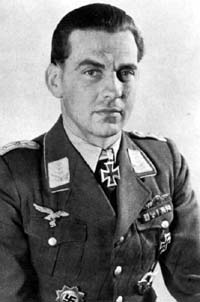
Hans Ehlers was a German military aviator who served in the Luftwaffe during World War II. As a fighter ace, he was credited with 55—that is, 55 aerial combat encounters resulting in the destruction of the enemy aircraft—claimed in an unknown number of combat missions. He claimed eleven victories on the Eastern Front and 44 over the Western Allies, including 23 four-engine bombers.

Franz Götz was a German Luftwaffe military aviator and wing commander during World War II. As a fighter ace, he is credited with 63 enemy aircraft shot down in 766 combat missions. The majority of his victories were claimed over the Western Front, including five four-engined bombers, with nineteen claims over the Eastern Front.

Jagdgeschwader 301 was a Luftwaffe fighter-wing of World War II. The order to form JG 301 was issued on 26 September 1943 and formed on 1 October 1943 in Neubiberg with Stab and three Gruppen (groups) as a "Wilde Sau" single-seat night fighter unit.
Herbert Rollwage was a German Luftwaffe military aviator and fighter ace during World War II. Depending on source, he is credited between 71 and 102 aerial victories achieved in 664 combat missions. This figure includes 11 aerial victories on the Eastern Front, and at least 61 victories over the Western Allies, including up to 44 four-engine heavy bombers.
Wilhelm "Willy" Kientsch was a German Luftwaffe military aviator and fighter ace during World War II. Kientsch claimed 53 victories all over the Western Front and North Africa in 295 combat missions. On 29 January 1944, Kientsch was killed in action when during aerial combat he crashed into the ground near Würrich. He was posthumously awarded the Knight's Cross of the Iron Cross with Oak Leaves on 20 July 1944.















